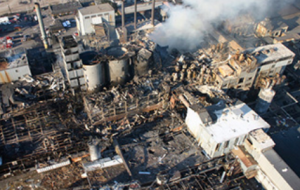Through the Cracks: Tips to Keep Dust Systems Clean
 Dust is dangerous. Unchecked, dust buildup on horizontal surfaces leads to a host of potential problems including air quality issues, lowered equipment performance, and even possible explosions. As noted by Powder Bulk Solids, keeping these systems clean is no easy task—fixing one concern in a dust system often uncovers several more. That said, how do you ensure safety doesn’t slip through the cracks?
Dust is dangerous. Unchecked, dust buildup on horizontal surfaces leads to a host of potential problems including air quality issues, lowered equipment performance, and even possible explosions. As noted by Powder Bulk Solids, keeping these systems clean is no easy task—fixing one concern in a dust system often uncovers several more. That said, how do you ensure safety doesn’t slip through the cracks?
What Causes Dust Explosions?
According to the OHSA, there are five critical elements required for a dust explosion: Fuel, oxygen, ignition, dust dispersion, and confinement of the dust cloud. If any of these elements aren’t present, catastrophic explosions become impossible—but even a single, small explosion can touch off multiple larger blasts as dust is dispersed around your facility. As a result, it’s critical to discover where dust hides, how it is generated, and put in place specific safeguards to ensure dust buildup is kept to minimal levels.
Here’s a quick list of some common explosive dusts:
- Agricultural products such as powdered milk, egg whites, or sugar
- Metals like aluminum, bronze or zinc
- Chemical dusts like coal or sulfur
- Wood, textile or plastic dust
- Dust caused in by the production of pharmaceuticals or pesticides
A Relevant Example
Consider the case of an idled paper mill in Canada. Although the facility itself was no longer producing any product, its dual boiler system remained online, using biomass fuel to keep the plant warm as workers conducted a facility cleanup in February 2014. In 2008, the plant’s dust risk was assessed and experts determined the fuel used to power the biomass boiler contained particulate matter moist and large enough that no hazard was present. During their cleanup, however, workers collected large amounts of fine, dry wood dust which was dumped into the conveyor system—creating the ideal conditions for an explosion. The result? One worker suffered severe burns when wood dust traveling through the conveyor system ignited a massive fireball.
Dust also presents the hazard of employee illness and equipment degradation. If dust is allowed to accumulate in “hidden” spaces or regular maintenance is scrapped in favor of ad-hoc cleaning the results range from lost productivity to workplace safety lawsuits.
How to Prevent Dangerous Dust
So how do you avoid the problem of dangerous dust? It starts with the recognition that virtually any dust is combustible. Bottom line: If it burns in solid form, it’s an explosion risk as dust. It’s also critical to investigate and clean “hidden” areas in your plant, which include any horizontal, out-of-the-way surface—HVAC ductwork or overhead joists, for example. It’s also a good idea to move your dust collectors outside to limit the risk of dust displacement should an explosion ever occur.
Regular cleaning is the other part of this equation. You can’t prevent the creation of dust but with a rigorous cleaning schedule and approved Class II condition equipment you can significantly lower the chance of dangerous dust. Better still, this means fewer problems to track down and more time to iron out system issues which impact performance and your bottom line—instead of merely “keeping up” with dust safety requirements.
Want to keep particulate safety from slipping through the cracks? Become a “dust detective”—find it, eliminate it, and keep it from coming back.
Next Steps:
- Subscribe to our blog to stay informed about the latest HVAC news and insight.
- Stay up to date on facility maintenance tools such as chiller tube cleaners, boiler tube cleaners, hose/pipe cleaners, descaler systems, industrial vacuums, commercial pressure washers, and drain cleaners.

